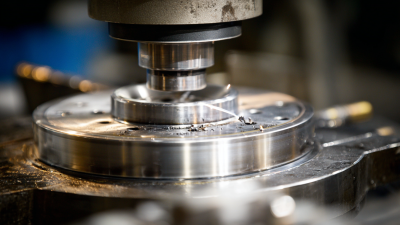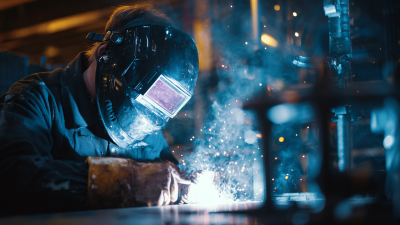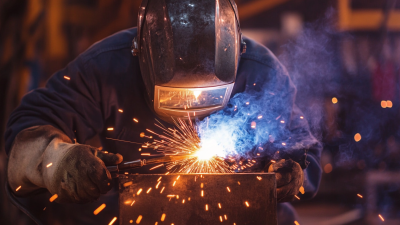In the world of manufacturing and fabrication, mastering stainless welding techniques has become imperative to ensure quality and efficiency. According to a report by the American Welding Society, the stainless steel market is projected to grow at a CAGR of 7.4% from 2021 to 2028, highlighting the escalating demand for this versatile material across various industries, including aerospace, automotive, and construction. The ability to perform stainless welding proficiently not only enhances structural integrity but also optimizes the overall production process.

As the industry increasingly shifts towards advanced welding technologies, understanding the nuances of stainless welding is essential for fabricators striving for seamless fabrication and superior performance in their applications. This article delves into the best practices and advanced techniques that are critical for mastering stainless welding, aiming to equip professionals with the necessary skills to thrive in a competitive marketplace.
Understanding the right stainless steel welding alloys is crucial for achieving high-quality and durable welds in fabrication. According to the American Welding Society (AWS), the most commonly used stainless steel alloys for welding include austenitic, ferritic, and martensitic types. Among these, austenitic stainless steels such as 304 and 316 are particularly favored due to their excellent corrosion resistance and fabricability, making them suitable for a wide range of applications, from food processing to chemical manufacturing.
Moreover, the selection of welding filler material plays a pivotal role in the quality of the final product. It’s noted in the "Welding Research Council" report that using the correct filler alloy can enhance the strength and corrosion resistance of the weld joint. For instance, using ER308L filler for welding 304 stainless steel ensures not only compatibility but also retains mechanical properties post-weld. With the market for stainless steel expected to grow significantly—projected by Global Industry Analysts, Inc. to reach $160 billion by 2026—the demand for skilled professionals who understand these welding alloys and can execute techniques proficiently will certainly increase. Emphasizing the significance of ongoing training in stainless steel welding processes is essential for maintaining high standards in the fabrication industry.
When it comes to stainless welding, having the right tools and equipment is crucial for achieving seamless fabrication. According to the American Welding Society, proper equipment not only enhances weld quality but also improves productivity, reducing rework and associated costs. Essential tools include TIG and MIG welding machines, which are widely recognized for their precision and efficiency. MIG welding, in particular, offers a faster welding process and is ideal for thicker materials, making it a popular choice in industries like automotive and construction.
In addition to welding machines, protective gear is vital to ensure safety during the process. OSHA reports indicate that over 50% of welding injuries are related to inadequate protective equipment. Thus, investing in high-quality helmets, gloves, and respirators is essential. Furthermore, accessory tools such as clamps, grinders, and brushes play a significant role in pre- and post-weld preparation. By equipping your workshop with these essential tools, you can significantly enhance your stainless welding capabilities, ensuring high-quality results and a safer working environment.
 Mastering the art of stainless welding techniques is crucial for achieving seamless welds, particularly in applications requiring precision and durability. Key techniques include proper joint preparation, which ensures clean surfaces free from contaminants, and optimal heat management during the welding process to prevent any distortion or weakening of the material. Additionally, utilizing advanced filler materials can enhance the structural integrity of the weld, resulting in a robust and aesthetically pleasing finish.
Mastering the art of stainless welding techniques is crucial for achieving seamless welds, particularly in applications requiring precision and durability. Key techniques include proper joint preparation, which ensures clean surfaces free from contaminants, and optimal heat management during the welding process to prevent any distortion or weakening of the material. Additionally, utilizing advanced filler materials can enhance the structural integrity of the weld, resulting in a robust and aesthetically pleasing finish.
The stainless steel seamless pipes market is projected to experience significant growth, driven by increasing demand from sectors such as oil and gas, where these pipes perform exceptionally well under high-pressure and corrosive conditions. As industries focus on enhancing manufacturing processes and adopting superior welding techniques, understanding these key methodologies becomes essential for long-term sustainability and competitiveness in the market. Furthermore, the impact of government policies aimed at bolstering domestic steel production will play a pivotal role in shaping the industry landscape, fostering innovation, and driving growth.
Stainless steel welding presents unique challenges that can hinder the success of fabrication projects. One common issue is improper heat input, which can lead to distortion or burn-through. To mitigate this, welders should adjust their parameters based on the thickness of the material and the specific type of stainless steel being used. Maintaining a consistent travel speed and technique can help distribute heat more evenly, reducing the risk of damaging the base material and ensuring a strong, aesthetically pleasing weld.
Another prevalent problem in stainless steel welding is the formation of weld defects, such as porosity or cracking. These issues often arise from contamination, inadequate shielding gas, or improper filler materials. To troubleshoot, it's crucial to inspect and prepare the workpiece meticulously, ensuring it is free from oils, rust, and other contaminants. Additionally, using the appropriate shielding gas and verifying its flow rate can significantly enhance weld integrity by safeguarding the molten pool from atmospheric contamination. By tackling these common issues with proactive measures, welders can achieve seamless and durable stainless steel fabrications.

When engaging in stainless welding projects, safety protocols are paramount to ensure a successful and risk-free environment. First and foremost, personal protective equipment (PPE) must be worn at all times. This includes enamel safety goggles, gloves, and flame-resistant clothing that can withstand the intense heat generated during the welding process. Proper ventilation is also essential to dissipate harmful fumes produced during welding, so working in a well-ventilated area or using exhaust systems can significantly reduce health risks.
In addition to PPE, it is crucial to maintain a clean workspace. Clutter can lead to accidents, so keeping the area free from debris and flammable materials is necessary for safe welding practices. Proper training is another critical element; welders should be familiar with the equipment and techniques before starting a project. Regular inspections of tools and machinery can prevent malfunctions and ensure a smooth operation. By adhering to these safety protocols, welders can create a sturdy and successful fabrication while minimizing risks associated with stainless welding.
| Technique | Description | Safety Protocols | Best Practices |
|---|---|---|---|
| TIG Welding | A precise welding method using a non-consumable tungsten electrode. | Use proper ventilation and personal protective equipment (PPE). | Maintain a clean work environment to avoid contamination. |
| MIG Welding | Utilizes a continuous wire feed as an electrode for welding. | Ensure shielding gas is used properly to prevent oxidation. | Set proper voltage and wire feed speed for optimal results. |
| Spot Welding | Welding technique that joins metal sheets using heat generated from resistance. | Keep hands and other body parts clear of the welding zone. | Use fixtures to hold materials in place for consistent results. |
| Plasma Arc Welding | An advanced welding technique involving superheated plasma to join metals. | Wear appropriate eye protection to shield from arc radiation. | Control the travel speed for better penetration and bead appearance. |






